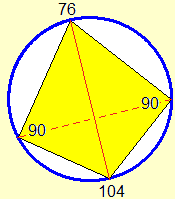By doing a few experiments I understand that for a quadrilateral the equivalence between having opposite angles of amplitudes that have a sum of 180 ° and being inscribable in a circle holds.
Despite the evidence, how do I prove it?
We know that all angles inscribed in a circle that intercept the same arc on it have the same amplitude.
So I can trace back each configuration to a situation such as the one on the side, in which the upper and the lower part are two isosceles triangles and, therefore, the right and the left part are two equal right-angled triangles: half of the opposite angles (those that in the figure are 76° and 104° wide) therefore they have a sum of

